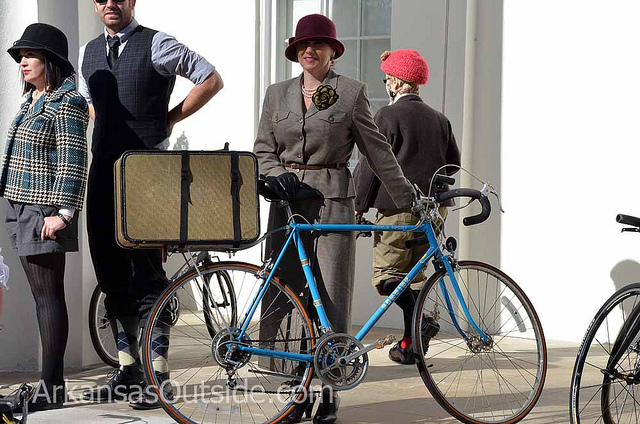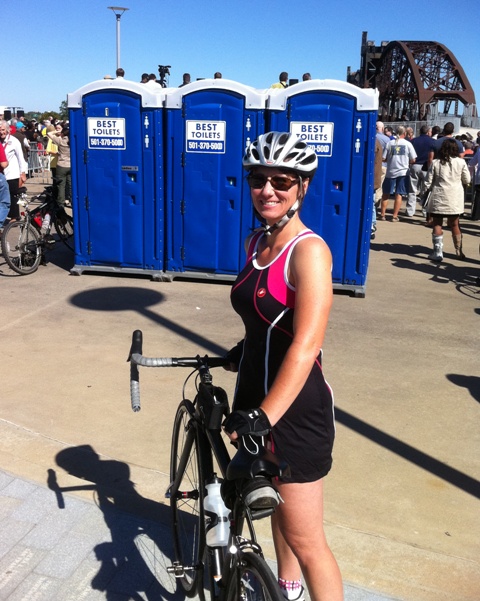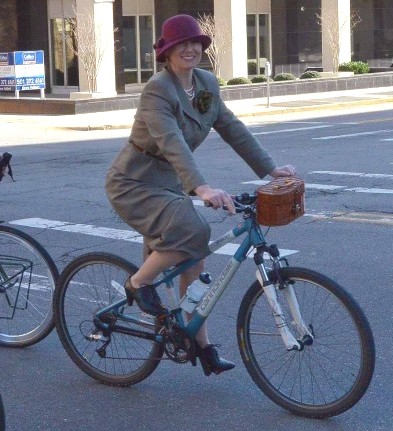Bikes, Babes and Bloomers {Women’s History}
Written by Lisa Mullis of Frenetic Fitness
In celebration of Women’s History Month let’s talk about clothes. We love them. We wear them. We use them to impress and to be comfortable. Some of us listened to our mothers complain about garters and girdles. Many of our daughters will remember us complaining of the days of pantyhose being all but required for the office or for church. But I have to wonder, as I slip into my spandex/lycra bike shorts and lightweight nylon jersey, what would it have been like to try to live my lifestyle of athletic outdoorswoman while wearing a rib crushing corset and a 15 pound multi-layer of crinoline and skirt?
As the 19th century came to a close, there were great improvements to an invention that was changing the way people traveled: enter the bicycle. Cycling in Europe was a rapidly emerging sport in the 1860’s and 70’s. In 1877 a man named Albert Pope imported a contraption called the Penny Farthing or the Ordinary bicycle from Britain to America.
His company, Pope Manufacturing, would begin producing the Columbia bicycles. In that same year, the fashionable woman might have been outfitted in an underskirt to support a bustle with layers of ruffles and frills, a tight fitting corset, and a long waisted tight fitting bodice with long sleeves and during the day, a high neck. I can’t imagine how women were supposed to travel by bicycle wearing all that but many of them did; and many were injured by skirts caught in wheels or chains. I’m betting a lot of skirts were ruined too. Tired of sweating under layers of cumbersome clothes and worried about getting thrown to the ground, or tearing a skirt, the need for reasonable cycling clothes spawned a new fashion trend of split skirts or shorter skirts with a type of trouser underneath.
Amelia Jenks Bloomer was the editor of The Lily, a women’s temperance magazine. She was one of the best known proponents of the movement that would spawn the Rational Dress Society. Aiming to rid women of the binding and physical hindrance of corsets and heavy layered skirts, Mrs. Bloomer promoted the wearing of Turkish Trousers. These trousers, which became known as “bloomers” due to her patronage, would become the basis for women’s cycling suits. Amelia passed away in 1894, just as female cyclists were gaining acceptance and divided skirts and bloomers were adopted as cycling attire. She herself gave up wearing the trousers most likely due to societal backlash. Men thought that allowing women to wear the bifurcated raiment then exclusively available to men, would lead to women expecting to compete for a man’s place in society. Even many women felt that the shorter skirts and knickerbocker style cycling suits were immodest and lessened the gracefulness that is the hallmark of the female sex.
But all hail the freedom that comes from riding a bike. As women took to the cycling club tracks, the parks, and the streets to ride their bikes they enjoyed a huge increase in freedom of movement. Young women could cycle away from the prying eyes of parents and wives were not reliant on husbands for transportation. Bikes not only gave them independence but also gave them the freedom of exercise because they had ditched those binding corsets, hitched up their overskirts and put on their bloomers. Elizabeth Cady Stanton was already in her 80s during the Golden Age of Bicycling but she had this to say about the benefits, “The bicycle will inspire women with more courage, self-respect and self-reliance and make the next generation more vigorous of mind and of body; for feeble mothers do not produce great statesmen, scientists, and scholars.” This unburdening of those weighty garments let women exercise out in the fresh air, possibly for the first time since they were young children at play around their mother’s heavy skirts and before conforming to the feminine ideal of the day.
And knowing all of this, I’ve attempted riding my bike wearing a long skirt as part of the first of what I hope is an annual event for Little Rock, the Tweed Ride.

Though my skirt was shorter and lighter than what women would have been wearing at the turn of the century, it still made riding more of a chore than wearing shorts or tights. Yet I’ve rarely had as much fun on my bike, especially with the knowledge that I didn’t ever have to wear that get up again if I didn’t want to. Instead I’ll stick to my short, tennis dress length bike skirt. You read me right; I own a spandex bike skirt. I wore it to the opening of the Clinton Library Bridge in Little Rock because I felt I should dress up for such an event.
As we sit around the house wearing yoga pants, or pull on shorts to head out for a run or to play with our kids at the park, as we put on our stretchy bike shorts with padded chamois, let’s give thanks to those women who were the bra burners of their day. And ride off into the sunset on our two wheeled steeds.
“[T]he bicycle will accomplish more for women’s sensible dress than all the reform movements that have ever been waged.” ~Author Unknown, from Demerarest’s Family Magazine, 1895
For all my homeschooling friends: I found this lovely book in the juvenile section of my library Wheels of Change: How Women Rode the Bicycle to Freedom by Sue Macy, check it out.
About Lisa: I’m a Wife and Mom. I’m a microbiologist. I’m a mountain biker, hiker, backpacker, sometime runner, and workout enthusiast all while being addicted to good food. I write about it at http://freneticfitness.wordpress.com. I also write for ArkansasOutside about other people who love to play outside too. I’m fueled by pizza, red meat and goat cheese risotto. And sometimes I sleep.




Great story about how we have evolved–even since bra burning days!
What a fun post Lisa! I’d never thought of a bicycle as a political/ fashion movement… or anything other than a wobbly ride. Thanks for sharing this perspective.
Paige I was amazed too! There is so much information out there about how bicycling changed the lives of woman at the turn of the century. Not only providing them freedom of movement and “throwing off the corset” but the bicycle became a very important tool for women to “network”. It was a great help to organizing not just for Women’s Right to Vote, but also for humanitarian efforts and religious volunteerism. Who knew? And what about now? check this article out http://girlbikelove.com/2011/12/women-in-cycling-why-we-matter-too/
And there are multiple organizations that use bicycle donations in rural areas (esp. in Africa) to help women ease their daily chores as a bike is the only transportation available to them other than on foot. Hoorah for the bicycle!